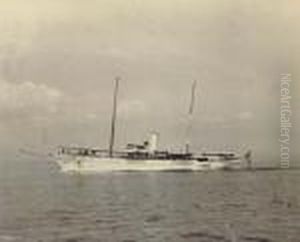Nathaniel Livermore Stebbins Paintings
Nathaniel Livermore Stebbins was an American photographer renowned for his work in maritime photography, capturing images of ships, yachts, naval vessels, and the burgeoning maritime industry of the late 19th and early 20th centuries. Born on January 9, 1847, in Meadville, Pennsylvania, Stebbins developed an interest in photography at a relatively young age, a passion that would ultimately define his professional career.
Stebbins moved to Boston, Massachusetts, which was a major hub for maritime activity, and this proximity to the sea provided ample subject matter for his work. His photographs are particularly significant because they document a transitional period in maritime history, from the age of sail to the advent of steam-powered vessels.
In addition to his maritime photography, Stebbins was also known for his architectural and landscape photography. He captured many images of buildings and cityscapes, offering a visual record of the changing urban environment during his time. His work was widely published and collected, cementing his reputation as a prominent figure in American photography.
Stebbins' photography business was successful, and his images were sought after not only for their artistic merit but also for their technical and historical value. He contributed to various publications and had his work displayed in numerous exhibitions. His dedication to the craft of photography and his ability to capture the essence of maritime life have left a lasting legacy.
Nathaniel Livermore Stebbins continued to work until his later years, leaving behind an extensive collection of photographs that offer invaluable insights into the maritime and architectural history of his era. He passed away on July 22, 1922, in Cambridge, Massachusetts. His photographs are preserved in various institutions and collections, including the Historic New England and the Peabody Essex Museum, ensuring that his contributions to photography and historical documentation are remembered and accessible to future generations.







